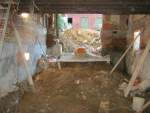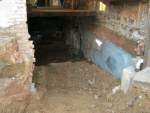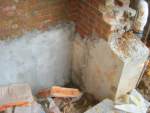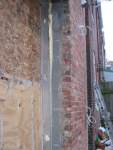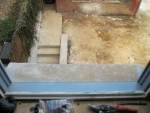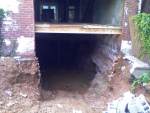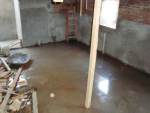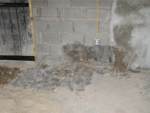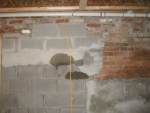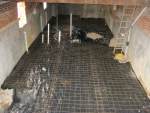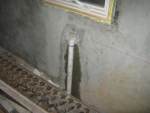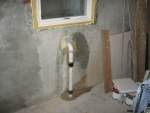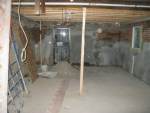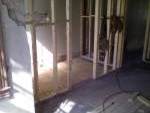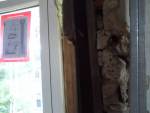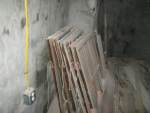We bought a wreck of a house in November 2009 and guessed that a renovation would take 4 to 6 months. How wrong we were. First it took 2 months to find a builder and then it was 15 months before we were able to move in and even then it wasn't ready.
We have had a difficult relationship with the builder and so I want to share our experience, offer some tips and warnings.
If you are considering buying a house that a builder has just renovated and is offering for sale, you have a simple yes/no decision based on what you see and most likely it will look great!
The difficulty comes when you engage the company to renovate your house. We have too often disagreed over what is included in the price, the quality of some of the workmanship and what constitutes “done”. We were in dispute because there were some defects that we believe must be fixed so we withheld final payment and they placed a Mechanics Lien on our property.
We hired the builder (which we can't name as part of the settlement) because they seemed to be significantly cheaper than other firms and part of that is due to having minimal office staff and minimal paperwork. I've often thought of engaging a builder is like asking someone to cook you dinner: you can either give someone detailed recipes for everything on the menu and watch over them to make sure that the instructions are followed exactly, or if your host is a good cook, they will whip up something fabulous from whatever happens to be in the kitchen with a minimum of fuss and maximum speed - you won't know what is coming but will be delighted when it arrives.
We received bids from Landis Construction and Kohler Homes (now renamed?) who fit in the first category. Landis was going to charge us $30,000 just to get the plans drawn up and Kohler was going to charge $1,500 just to measure the house so they knew exactly what they were working with. In both cases I'm sure the results would have been wonderful and there would not have been any argument over what was and was not included as everything was to be detailed up front. The only problem was that their overall price was going to greatly exceed how much money we had available to spend.
The builder we chose seemed to be in the second category. We had seen some of the work they had done and Jeff spoke to us about some good ideas he had for our project. The condition of the house was so bad that the only option was to rip everything out and start again. He seemed to know what he was doing and wanted to get moving as soon as possible on demolition while plans were drawn up to obtain building permits. (We also spoke with Jannsen Design who were slightly more expensive and with the benefit of hindsight, I wish we'd gone with them.)
We were surprised that they wanted us to sign their general contract with them without providing a detailed scope of work document so I created my own which pulled together the conversations we'd had and the emails we'd exchanged. I also used Google's (free!) Sketchup software to create some diagrams of what we were expecting. A "bid sheet" was included with the contract which was just a spreadsheet of costs in each category to arrive at a total.
Demolition started and we were surprised but pleased that they chose to take out all the internal walls upstairs rather than trying to modify what was there. In truth not much was going to stay put so it was just easier to take it all out. There were hurdles getting permits but the real trouble started when excavation of the basement commenced, both because a Stop Work Order was placed on the property for permit violations and because of the discovery of ground water. If it wasn't for the basement and the delays, extra expenses and arguing it caused, especially after the back corner of the building subsided, I think we would have ended on good terms but that isn't how it worked out.
We expected them to jump on the issues raised by the DCRA inspector that issued the Order and work would resume within a few days. Instead it took two whole months until the Order was lifted but then another 6 weeks or so before work really got started again. In the meantime, the windows had been delivered so they installed them to get them out of the way - it was a pity that they didn't bother to repair the window frames first (this one for example). At the time the windows were only held in by a few screws each side so I assumed they would be removed to repair the frames but then they were painted and the gaps filled with expanding foam. As you can see here, it looked terrible and it indicated that they weren't going to do proper paint preparation so I bought a sander and did one window myself to show the standard I expected . It seemed ridiculous that I should have to do that.
At this point, the builder insisted on renegotiating the payment schedule which we reluctantly agreed to but to compensate, we had a clause inserted promising a move in date 3 months after concrete for the basement slab was poured. After the initial rush of activity, it seemed they had lost focus once the Stop Work Order was issued and since we were spending money to rent somewhere else, any delays were costing us significant money.
Since the ground was wet reducing its bearing capacity and the opening in the back wall was wider than it should have been concentrating the load, the back corner of the house subsided while the foundations were being underpinned (back wall and side wall). Since it is a row house, it also caused cracking in our neighbor's house!
The builder initially said that the back wall would be rebuilt but between our weekly inspections they did their best to patch up what was there. You didn't have to look that carefully to see that it wasn't straight (wall at back door and back window). We argued for weeks over whether that was adequate and his argument was that plenty of houses on Capitol Hill have walls that lean so it wasn't a problem. In the end we put in a complaint with the DC Attorney General's office which prompted him to rebuild it properly.
The contract didn't address who owns any materials of value removed from the old house and the builder took a few things we wanted to keep. We did ask that the garage be fixed first so it could be locked; it wasn't and our canoe was stolen.
The bid sheet was also vague as the allocation for “tiles” was not the material cost alone but also included installation labor. I was hoping to do a “geothermal” heating/cooling system which only specialist companies handle; in the end we went with a conventional high-efficiency system with that other company but the builder only gave us a 90% credit of the amount on the bid sheet since they still needed to oversee their work. My point is not that is necessarily unreasonable but there needed to be more detail to avoid nasty surprises.
We moved in at the beginning of April, 2 weeks after the promised completion time and 15 months after we signed the contract but we didn't get hot water for a week and kitchen countertops/sink for 12 days.
Since the basement was complete, we've had problems with water penetration and the builder addressed most of them in some way or other. After heavy rains we saw this wet patch under the middle basement window and the damp patch at the floor actually formed puddles. With dampness like this, we can't finish the basement so we are witholding payment.
We later engaged N.V. Waterproofing to fix the basement and they did an excellent job. A trench was dug along the front and east wall down to the bottom of the new underpinning. The plan was to apply a plastic membrane to prevent water entry but once the underpinning was exposed, it was found to be too thin in places and so had to be reinforced. After that was done the membrane was applied and the soil backfilled. It was quite a job and in the end cost $37,500 but it was money well spent as we can stop worrying about it now. Several heavy rains since have demonstrated its effectiveness.
Additionally, while we recognize that the a significant amount of work was done on the repairing the floors, the floor in the living room still doesn't look right as seen here and here. There are a few other minor things but that covers the main issues.
So, at least for us, "significantly cheaper" did not translate to better value. If you are thinking of engaging a builder to do major renovation work:
- Get your own architect to draw up detailed plans and a scope of work for you so that both parties know exactly what is expected of them and they can also advise you on what's normal for the industry if you think something is questionable. The builder's architect was cheap but hopeless. I used to be an engineer and I spent a lot of time trying to modify his drawings to make them acceptable to the DCRA. This is his marking up of the “plat diagram” (the diagram itself showing the property boundaries is supplied by the city so to get the permit you must mark the diagram with existing structures and proposed improvements). It will be a large fee up front but it will be more than made up for later on.
- Get a lawyer to look over the contract. In retrospect it was remiss of us to accept a contract drawn up by the builder without review by someone more knowledgeable than us.











